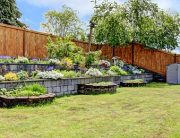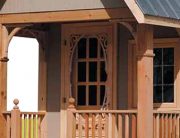Job Description
Extra guests? Need an extra seat? Check out this simple but classic lawn chair.
Lumber Required:
- 6 pieces of 2″ x 4″ – 8 foot length
- 3 pieces of 1″ x 6″ – 8 foot length
Materials List:
- 17 linear feet of 2 x 4 pine
- 30 linear feet of 1 x 4 pine
- 95 – 2 1/2″ wood screws
- 4 – 3 1/2″ carriage bolts
- 4 – 3 1/2″ lag screws
- Glue
Tools Needed:
- Circular Saw or Handsaw
- Hammer
- Drill
- Bar clamps
- Screwdriver
- Straight Edge
- Tape Measure

Step 1 – Building the Seat
Cut one Seat Front (A) from 1 x 4 pine x 20″ long. Cut two Seat Sides (B) from 2 x 4 pine x 19″ long. Position the two Seat Sides (B) on edge, parallel to each other and 17″ apart. Fit the Seat Front (A) over the end of the Seat Sides (B), as shown in figure 1.
Apply glue to the meeting surfaces, and screw through the Seat Front (A) into the ends of Seat Sides (B), using two 2 1/2″ wood screws on each joint. Cut five Seat Slats (C) from 1 x 4 pine x 20″. Place the seat assembly -Seat Front (A) and Seat Sides (B) &endash; on a flat surface. Position the five Seat Slats (C) over the assembly, as shown in figure 2. The first Seat Slats (C) should be set back 1/2″ inch from the face of the Seat Front (A), and the Seat Sides (B), using two 2 1/2″ wood screws on each joint.

Step 2 – Building the Back
Cut two Back Supports (D) from 2 x 4 pine x 14 1/2″ long. Cut five Backs (E) from 1 x 4 pine x 20″ long. Position the two Back Supports (D) on a flat surface, parallel to each other and 13″ apart. Position one Back (E) over the two Back Supports (D), as shown in figure 3. The first Back (E) should overhang the ends of the two Back Supports (D) by 1″ on each side.
Apply glue to the meeting surfaces, and screw through the Back (E) into each of the Back Supports (D), using two 2 1/2″ wood screws on each joint. Position remaining 4 Backs (E) to the two Back Supports (D).

Step 3 – Building the Sides
Cut two Arms (F) from 1 x 4 pine x 21″ long. Using figure 4 as a guide, shape the one Arm (F) by cutting off the shaded portions. Use the shaped Arm (F) as a pattern to cut the remaining Arm (F). Cut four Arm Supports (G) from two 2 x 4 pine x 24″ long.
Position two Arm Supports (G) on a level surface, parallel to each other and 12″ apart. Place one Arm (F), uncut edge down, over the ends of the two Arm Supports (G), as shown in figure 6. The Arm (F) should overlap each of the Arm Supports (G) by 1″ on each side. Apply glue to the meeting surfaces, and screw through the B Arm (F) into each of the Arm Supports (G), using two 2 1/2″ wood screws on each joint. Place remaining 2 Arm Supports (G) to remaining Arm (F) to complete other side.

Step 4 – Attaching the Arms
Draw a line across the inside of each Arm Support (G) 18″ from the unattached end. This will be the placement line. The object is to clamp the assembled seat between the two side assemblies (as shown in figure 6), then secure the seat with carriage bolts.
The top of the seat should be positioned at the placement lines you drew on the Arm Supports (G). The front Arm Support (G) should be positioned 2″ from the front of the seat assembly. When the sides are in position, clamp the two sides and seat assemblies tightly together, using bar clamps.
Drill a hole slightly larger than the diameter of the 3 1/2″ carriage bolts through the center of each of the Arm Supports (G) and the Seat Sides (B). Then insert a 3 1/2″ carriage bolt through each of the holes. Tighten the bolts securely.

Step 5 – Adding the back
Insert the back assembly between the two assembled sides. The Backs (E) should face the front of the chair, and the recessed end of the two Back Supports (D) should be at the top of the chair. To make the chair more comfortable, tilt the back assembly at a slight angle, out at the top and at the bottom. The tilt angle is determined by the width of the 2 x 4 on the Arm Supports (G) and the back of the Arm (F).
When the back is fitted perfectly, secure the assembly with bar clamps. Screw through the Arm Supports (G) into the Back Supports (D) using two 2 1/2″ wood screws. Then insert a 3 1/2″ lag screw through the Arm Supports (G) and into the Back Supports (D).
Step 6 – Finishing
Fill any cracks, crevices or screw holes with wood filler. Sand the completed chair thoroughly. Paint or stain the chair the color of your choice or simply leave it natural.
Be sure to practice workshop safety at all times.




